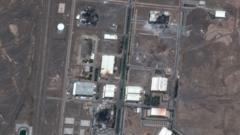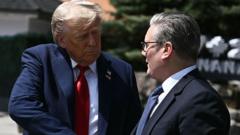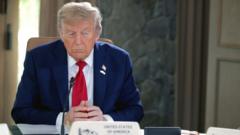In a significant turn of events at the G7 summit, President Trump departed early, emphasizing the increasing urgency of the Iran-Israel hostilities as he headed back to Washington.
Trump Exits G7 Summit Early Amid Escalating Iran-Israel Tensions

Trump Exits G7 Summit Early Amid Escalating Iran-Israel Tensions
U.S. President cuts short Canada summit to address growing Middle Eastern conflict
As tensions continue to escalate between Israel and Iran, President Donald Trump made an unexpected early exit from the Group of Seven summit in Canada, citing pressing matters concerning the Middle East. Upon his departure, he indicated the need for immediate attention to the situation, with reports emerging that he had instructed the National Security Council to convene upon his return to the U.S.
Despite the abrupt exit, the White House affirmed that Trump had a productive summit, highlighting progress made on a trade agreement between the U.S. and the U.K. However, his departure means he will miss scheduled discussions with both Ukrainian President Volodymyr Zelensky and Mexican President Claudia Sheinbaum on the summit's final day.
In the last few days, the conflict between Iran and Israel has intensified, with both nations exchanging attacks for five consecutive days. On social media, Trump expressed frustration with Iran, urging them to accept a deal that the U.S. proposed during nuclear talks, reiterating, "IRAN CAN NOT HAVE A NUCLEAR WEAPON."
The ongoing conflict has prompted air raid sirens to blare in Tel Aviv as Iranian missiles targeted Israel, marking a severe escalation. As explosions rattled Tehran, the Iranian government reported significant damage, with rising casualties from the airstrike exchanges.
While many world leaders at the G7 acknowledged Trump's early departure due to the crisis, discussions on the summit’s conclusion seemed contentious, particularly regarding statements on the Iran-Israel conflict.
In a bilateral meeting, Trump reinforced his administration's diplomatic approach toward the U.K. by formalizing a tariff agreement, garnering positive responses from British Prime Minister Sir Kier Starmer. However, tensions remained palpable as the summit struggled to reach a unified front regarding policy in the Middle East, and conflicts over Russia were also at the forefront.
This is not the first time Trump has opted for an early exit, having previously left the G7 in 2018 to meet North Korean leader Kim Jong Un, adding to an increasingly complex international landscape characterized by rapid geopolitical changes.
Despite the abrupt exit, the White House affirmed that Trump had a productive summit, highlighting progress made on a trade agreement between the U.S. and the U.K. However, his departure means he will miss scheduled discussions with both Ukrainian President Volodymyr Zelensky and Mexican President Claudia Sheinbaum on the summit's final day.
In the last few days, the conflict between Iran and Israel has intensified, with both nations exchanging attacks for five consecutive days. On social media, Trump expressed frustration with Iran, urging them to accept a deal that the U.S. proposed during nuclear talks, reiterating, "IRAN CAN NOT HAVE A NUCLEAR WEAPON."
The ongoing conflict has prompted air raid sirens to blare in Tel Aviv as Iranian missiles targeted Israel, marking a severe escalation. As explosions rattled Tehran, the Iranian government reported significant damage, with rising casualties from the airstrike exchanges.
While many world leaders at the G7 acknowledged Trump's early departure due to the crisis, discussions on the summit’s conclusion seemed contentious, particularly regarding statements on the Iran-Israel conflict.
In a bilateral meeting, Trump reinforced his administration's diplomatic approach toward the U.K. by formalizing a tariff agreement, garnering positive responses from British Prime Minister Sir Kier Starmer. However, tensions remained palpable as the summit struggled to reach a unified front regarding policy in the Middle East, and conflicts over Russia were also at the forefront.
This is not the first time Trump has opted for an early exit, having previously left the G7 in 2018 to meet North Korean leader Kim Jong Un, adding to an increasingly complex international landscape characterized by rapid geopolitical changes.






















